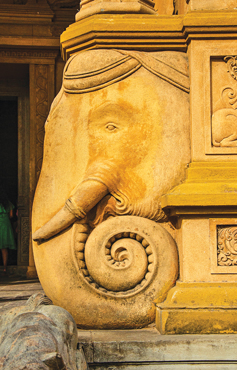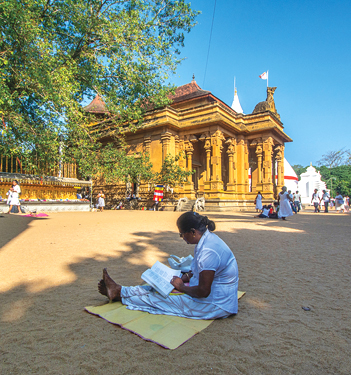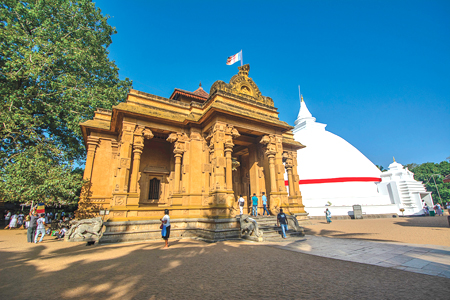 The high regard for Kelaniya among the Buddhists is demonstrated by a popular anecdote which we have heard as children. Sung as a verse, it reads: Upan da sita karapu pavu netha – Varak vendoth Kelaniye. Though it claims that one’s sins will be washed away once the person worships at Kelaniya, it is a highly exaggerated statement intended to get devotees to go at least once and worship there.
The high regard for Kelaniya among the Buddhists is demonstrated by a popular anecdote which we have heard as children. Sung as a verse, it reads: Upan da sita karapu pavu netha – Varak vendoth Kelaniye. Though it claims that one’s sins will be washed away once the person worships at Kelaniya, it is a highly exaggerated statement intended to get devotees to go at least once and worship there.
The Kelaniya temple is one of the most important places of worship for Buddhists in and around the capital. It nestles in spiritual surroundings on a higher terrace on the banks of the Kelani Ganga outside the highly urbanised Kelaniya city, ten kilometres Northeast of Colombo Fort, a short detour off the Kandy road.
I got a chance to visit this temple one sunny day last week, prior to the Duruthu festival. The Duruthu Full Moon Poya Day, which falls on Thursday, January 25, indeed, is always special for the Kelaniya Raja Maha Vihara, one of the three places on the island, that the Buddha made a special point of visiting.
The temple has played an important role in nurturing and spreading Buddhism globally. It not only provides a fascinating insight into Sinhala culture and history, but also features some delightful murals and carvings, including a frieze of dwarfs frozen in a range of enchanting gestures.
It is worth approaching the temple slowly to take in all the details on the way. It lies on a man-made hillock on a plain by the banks of the Kelani Ganga. At the foot of the flight of steps facing the river are heads of the mythical figure of a dragon, each with a trunk pointing straight ahead, as can be seen outside most ancient temple entrances. Elephant dwarfs are believed to have great protective powers, which is why the main temple is ringed with them.
Three great symbols

The elephant image at the temple entrance, whose trunk has been worn out by the topping of coins for good luck
At the top of the steps standing beneath a stately archway, visitors face the three great symbols of the Triple Gem: On the right is the dagaba, representing the living presence of Buddha, in the centre is the main temple building, signifying the Sangha and finally, on the left is a thriving Bo tree, which reminds us of the Buddha’s enlightenment and as such symbolises his teachings. Facing the dagaba are encased statues of Vihara Maha Devi and the newly-built statues of Avalokitheswara Bodhisatwa, in both corners.
The dagaba appears enormous in size. The Kelaniya dagaba is said to contain buried within its depths, a gem-studded throne on which the Buddha sat on his second visit here. It is venerated by the local faithful who walk round it piously, heads bowed and floral offerings clasped between their palms. The dagaba is in the form of a paddy–heap, one of the earliest styles found in Sri Lanka and reaches a height of almost 30 metres.
Seeming to take nourishment from the offerings of devotees at its base, the age-old majestic Bo tree spreads its boughs wide, offering shade for those who come to pay their respects.
The tree is surrounded by a golden railing and has a simple stone Buddha image among its roots. Devotees bring lotus, water lilies and frangipani to decorate the ledge around the tree’s base, and the pungent aroma of incense pervades the area.
While standing under the Bo tree, I saw a stream of devotees move through the temple carrying pots of water on clasped palms, doing seven rounds under the tree chanting stanzas, offering and lighting incense and bringing newborns for blessing and initiation into the religion.
The sandy temple compound is filled with devotees with various offerings engaging in ritualistic activities. The exact date of the temple’s origin is unknown, but the original dagaba is ascribed to King Yatala Tissa of the 3rd Century BC.

Devotees sit on the temple ground for veneration
The Portuguese the first of the three European powers to subject Sri Lanka to colonial rule destroyed the Kelaniya temple. Flanked by these natural and man-made symbols, the main temple building is an imposing structure that owes its existence to local philanthropist and Buddhist devotee Helena Wijewardene.
The Wijewardene family’s religious inclination led to a resurgence of faith, and they secured donations sufficient for the restoration of the shrine of the Kelaniya temple, which had fallen into disrepair. After restoration, the delightful friezes and many of the temple’s best murals were added during the 20th century by renowned artist Solius Mendis, whose work has drawn comparisons with creations from the age of Polonnaruwa in the 12th century. Having observed some of these floral designs on temple pillars at the Kelaniya temple, I realised that some are similar to the carvings at the Lake House building which was owned by D. R.Wijewardene.
Chubby dwarfs
The viewer is instantly endeared by the chubby dwarfs, with their modest expressions and unusual postures. All of them play a part in seeming to support the temple wall, yet none of them appear to suffer from the effort. Some of them stand on their hands, and some face inwards, while others blow on their flutes. Here and there plump fingers rest on rounded buttocks or a pudgy stomach, giving a sense of innocent sensuality.
The dwarfs are set between other friezes of geese, representing the distinction between good and evil, and elephants. The rest of the temple walls is decorated with sculptures of humans and deities, more dwarfs and creatures that seem to be a combination of various species. Beside the steps to the main entrance, the curled trunk of a protective elephant has been worn out by the tapping of coins on it for luck.

The main temple building of Kelaniya and the white dagaba
On entering the temple, the first sight is a massive carving of the Naga King Maniakkitha. The walls and ceilings of the temple interior are covered with richly coloured and sharply detailed murals by Mendis recounting both the Buddha’s life and episodes in the history of the temple.
The massive paintings that Mendis has drawn in the interior of the image house depict the arrival in Sri Lanka of the Buddha’s tooth hidden in the hair of a princess, Hemamala and bhikkuni Sangamiththa carrying the Sacred Bo sapling (Jaya Sri Maha Bodhi) from India which was handed over to King Devanampiyatissa at Dambakolapatuna.
A painting, of a blue sky with a single mountain peak and a gold-plated seated Buddha statue with intricately carved pillars and visitors who prostrate and sit in silent prayer, adorns the temple’s interior.
The pious activities of its devotees, as much as the temple’s fine sculptures and paintings, make a visit here a spiritual experience. Worshippers come every day of the week, but on a Full Moon Poya day, it gets very crowded. The biggest crowds of all turn out for the temple’s annual Duruthu Perahera which begins on the Duruthu Full Moon Poya Day, when people and elephants alike are dressed in their finest for an unforgettable pageant.






